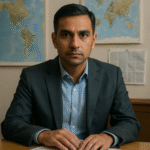Anchorage, August 15: On an unusually brisk summer morning, the gates at Joint Base Elmendorf-Richardson swung open under the scrutiny of armed guards and television lenses from around the globe. By mid-day, the Arctic sky over Anchorage, Alaska would frame one of the most politically loaded handshakes of the decade Donald Trump and Vladimir Putin, face to face on U.S. soil for the first time in years, with a war still raging an ocean away.
Alaska’s Loaded Symbolism
For many, the choice of Alaska was no accident. The state’s history as former Russian territory, sold to the United States in 1867, has long made it a curiosity in diplomatic lore. Its location, perched on the edge of the Arctic and just a few hours’ flight from Russia’s Far East, now doubles as strategic geography. As TIME reported, it also happens to be one of the few American venues where Putin could safely land without fear of arrest under the International Criminal Court’s warrant.
That combination of symbolism and practicality has turned Anchorage usually associated with fishing fleets and long summer days into an unlikely stage for hard geopolitics.
A Compressed Timeline, A High-Risk Agenda
The summit, scheduled for 11 a.m. Alaska Time (1900 GMT), comes with stakes that go far beyond the optics. According to Axios, the stated aim is to pursue a ceasefire in the Russia–Ukraine conflict, now deep into its fourth year. There is talk of arms control, economic cooperation, and the possibility of “territorial compromises” involving Crimea, Donetsk, and Luhansk.
The catch: Ukraine is not at the table. European leaders are absent too, a detail that has set off alarms in Brussels and Kyiv. Ukrainian President Volodymyr Zelenskiy has already rejected any settlement that cedes territory without his country’s consent, while analysts quoted by The Washington Post warn that the setup risks granting Putin a symbolic diplomatic win positioning Russia as the party open to peace while sidelining its primary adversary.
A Chilly Reception at Home
In Alaska, the rollout has been anything but smooth. Anchorage Mayor Suzanne LaFrance told The Daily Beast she learned about the summit not from federal briefings but from social media. “It was a surprise,” she admitted, adding that local officials were only looped in after the announcement went public. Since then, security coordination with state and federal agencies has been intense, though details remain under wraps.
For the city, the event is unprecedented not only Putin’s first U.S. visit in over a decade, but also the first visit by a Russian head of state to Alaska, as noted by Al Jazeera. The combination of history, distance, and raw political stakes has turned Anchorage into a temporary nerve center of global diplomacy.
Trump’s Pitch, Putin’s Play
Trump has struck an optimistic tone, telling Reuters he believes Putin “will make a deal,” hinting that sanctions may be pushing Moscow toward compromise. He has also floated the idea of inviting Zelenskiy to Alaska for a three-way meeting, calling it “logistically easiest.”
Putin, meanwhile, is expected to leverage the platform to propose a nuclear arms control deal in exchange for sanctions relief. While such a move could appear constructive on paper, Western officials worry it is a calculated bid to fracture the Western alliance’s consensus on Russia a tactic consistent with Moscow’s diplomatic playbook since 2014.
The Global Lens on Anchorage
International reaction has been mixed. Some diplomats view the Alaska meeting as a potential breakthrough, especially if it results in even a temporary halt to fighting. Others see it as a dangerous precedent, bypassing established multilateral frameworks and giving Moscow an opportunity to reset its image without making meaningful concessions.
For the Biden-era foreign policy establishment now largely sidelined under Trump’s return to office the summit underscores the shift toward bilateral deal-making. As one European official told El País, “This is not how durable peace is built. This is theater with high stakes.”
Streets Quiet, Airspace Locked Down
By sunrise, Anchorage’s streets near the military base were unusually still. Airspace restrictions had gone into effect, with commercial flights rerouted and security cordons in place. Locals swapped sightings of motorcades and foreign press vans at coffee shops, a rare collision between small-city normalcy and world-class geopolitics.
Yet beneath the calm, the stakes were visible in every detail from the guarded Russian diplomatic convoy to the watchful posture of U.S. military police. The Arctic light cast long shadows on a day that could alter the trajectory of a war, or simply etch another image into the long, uneven history of U.S.–Russia relations.
A Meeting Measured in Optics as Much as Outcomes
No matter the summit’s final communiqué, the optics are already fixed: a smiling Trump and a deliberate Putin, photographed on land once claimed by the Tsar, in a meeting arranged with minimal involvement from America’s traditional allies. For Putin, that image alone may be worth the trip. For Trump, it offers a chance to cast himself as the deal-maker who can stop a war others could not.
Whether the people of Ukraine or indeed the rest of the world will benefit from what happens behind those closed doors is a question that will outlast today’s headlines.
Stay ahead with Hindustan Herald — bringing you trusted news, sharp analysis, and stories that matter across Politics, Business, Technology, Sports, Entertainment, Lifestyle, and more.
Connect with us on Facebook, Instagram, X (Twitter), LinkedIn, YouTube, and join our Telegram community @hindustanherald for real-time updates.
Specializes in South Asian geopolitics and global diplomacy, bringing in-depth analysis on international relations.






